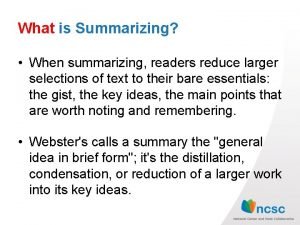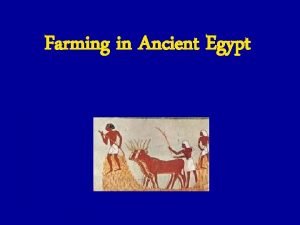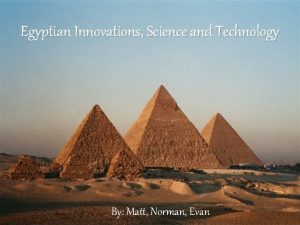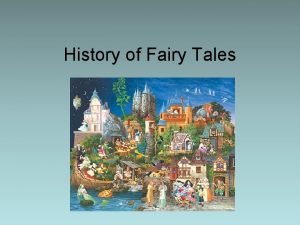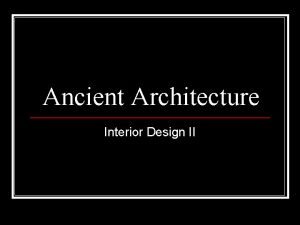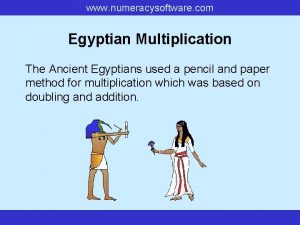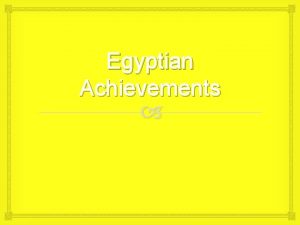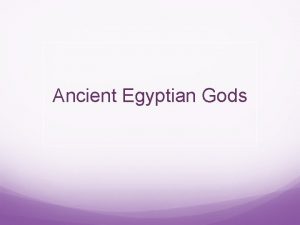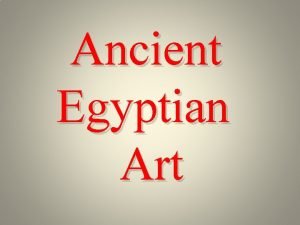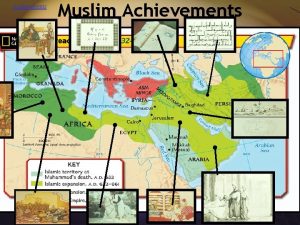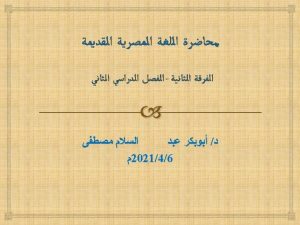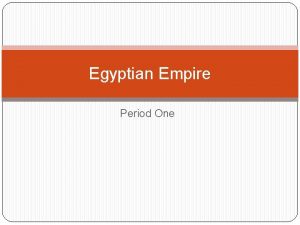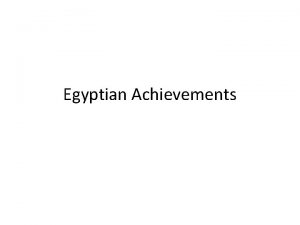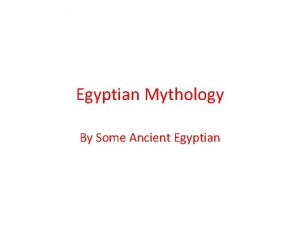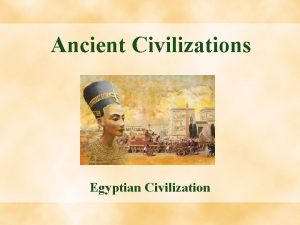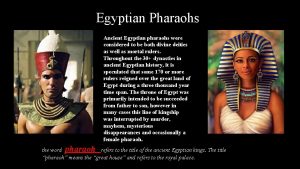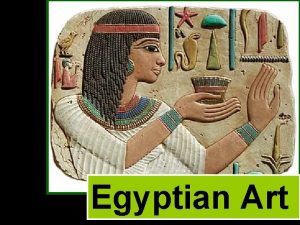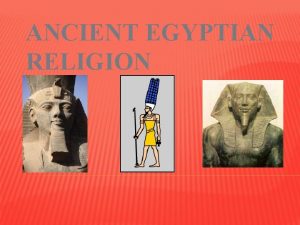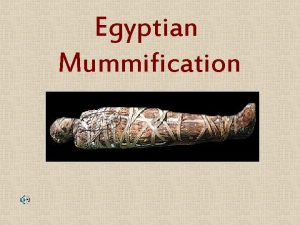Ancient Egyptian Achievements 6 19 Summarize important achievements


















- Slides: 18

Ancient Egyptian Achievements 6. 19 -Summarize important achievements of Egyptian civilization, including: *The agricultural and irrigation systems *Invention of a calendar *Monumental architecture and art, such as pyramids and the Sphinx of Giza *Evolution of writing-hieroglyphics *The invention of papyrus

Agriculture & Irrigation The Nile provided rich soil (from the silt) and water, producing three to four times more crops than regular rain-fed soil. - made farming very productive, created a surplus The Egyptians invented the shadouf to help distribute water to the fields. The Shadouf is a long balancing pole with a weight on one end a bucket on the other. The bucket is filled with water and easily raised then emptied onto higher ground. The Egyptians invented the plow.

Calendar The Egyptians devised the solar calendar by recording the yearly reappearance of Sirius (the Dog Star) in the eastern sky. It was a fixed point which coincided with the yearly flooding of the Nile. Their calendar had 365 days and 12 months with 30 days in each month and an additional five festival days at the end of the year. However, they did not account for the additional fraction of a day and their calendar gradually became incorrect. Eventually Ptolemy III added one day to the 365 days every four years. Agriculture Inundation: June - October - SHAIT time of rising flood waters farmers had time to build Emergence: November - February- PIRUIT the return of the water to the river planted crops & trapped water for irrigation Drought: March - June – SHEMU Harvest time

Monumental Architecture The oldest pyramid was for King Zoser between 2667 -2648 BC. In fact it is the first monumental stone building designed and constructed that we know of. The Pyramids of Giza With the red pyramid, Sneferu set the standard for all true pyramids to come. He included above ground burial chambers, a mortuary temple, and a causeway leading down to a valley temple. This was the model followed by his son, Khufu, who built the first and largest pyramid at Giza. The Giza pyramids were on a rocky plateau on the west bank of the Nile in northern Egypt and were connected, by covered causeways, to mortuary temples in the valley below the plateau. These temples had landing stages which were linked to the Nile by a canal. In ancient times they were included among the Seven Wonders of the World.

The Sphinx stands before the Pyramid of Pharaoh Khafre. The Sphinx was carved from a single block of limestone left over in the quarry used to build the Pyramids. The Sphinx is said to represent the body of a lion and the head of a pharaoh.

Obelisk • • An obelisk was a monument made of stone. Each obelisk was placed in a public place. In ancient Egypt, obelisks were often built in pairs. Some were not very high. But some were seventy feet (70 feet!) tall. A few were even taller! They were very heavy and very impressive. An obelisk has four sides and tapers towards the top to a pyramid shaped point. In ancient Egypt, these huge structures were cut from one huge piece of incredibly heavy stone. The ancient Egyptians were clever. They found a way to stand these huge stones upright after they had been decorated and carved with writing telling of the wonderful life and great achievements of the person each obelisk honored. The pharaohs ordered these huge monuments built for them so that they would always be remembered. The writings on the obelisks tell us a great deal about the ancient Egyptian civilization. Most obelisks were commissioned by pharaohs, but anyone could build one if they had the money.

Temples • • The temples were the landowners, the centers of administration, and the possessors of all wealth. For 3, 000 years they maintained cultural continuity, upheld the authority of the rulers, and safeguarded the social structure. Eventually they became political powerhouses as well, their high priests wielding as much, if not more, power than the pharaoh himself. Temples fell into two principal types: cult temples and funerary or mortuary temples. The cult temples housed images of the gods, while the mortuary temples were created as shrines to dead kings. Karnak Temple dates from around 2055 BC to around 100 AD

Art Ancient Egyptian art is the painting, sculpture, architecture and other arts produced by the civilization of ancient Egypt in the lower Nile Valley from about 3000 BC to 30 AD. Ancient Egyptian art reached a high level in painting and sculpture, and was both highly stylized and symbolic.

A System of Writing • The Ancient Egyptians had no separate word for “art”, their word for “art” was the word for “writing”. • This Egyptian “alphabet” was made up of about 800 picture-symbols called HIEROGLYPHS. • The word HEIROGLYPHICS means “sacred writing”

A System of Writing • The Egyptians considered HIEROGLYPHS sacred and believed that they conveyed the words of the gods. • HIEROGLYPHICS also helped to preserve the memory of deceased people. • In order to keep track of government records, taxes, and the passage of time, the Egyptians developed a system of writing called HIEROGLYPHICS.

A System of Writing Not all Egyptians could read or write hieroglyphics: SCRIBES: ∆ Pharaoh’s record keepers ∆ Very Educated in reading, writing & math ∆ Highly respected ∆ Only boys could become SCRIBES ∆ A SCRIBE’S training started at the age of 10 ∆ SCRIBES used rolls of PAPYRUS to write on Only the SCRIBES used HIEROGLYPHICS.

Evolution of Writing Hieroglyphics • The Rosetta Stone was the key that unlocked the mysteries of Egyptian hieroglyphics. • Napoleon's troops discovered it in 1799 • The inscription is written on the stone three times, once in hieroglyphic, once in hieratic, and once in Greek. • Jean Francois Champollion, a French Egyptologist, deciphered the hieroglyphic and hieratic texts by comparing them with the known Greek text.

A System of Writing • The Common people of Egypt used a form of writing called “hieratic”, a form of script writing. • Eventually, the responsibility of reading & interpreting the HIEROGLYPHS fell to the priests. Even SCRIBES lost the ability to read the ancient symbols. • By 400 AD, no one could read the HIEROGLYPHS anymore.

A System of Writing PAPYRUS: • The earliest form of paper. • Made from the papyrus reed that grew in the Nile. • The reeds would be criss-crossed and pounded down to a paper-like thickness.

Invention of Papyrus sheets are the earliest paper-like material – all other civilizations used stone, clay tablets, animal hide, wood materials or wax as a writing surface. Papyrus was, for over 3000 years, the most important writing material in the ancient world. It was exported all around the Mediterranean and was widely used in the Roman Empire as well as the Byzantine Empire. Its use continued in Europe until the seventh century AD, when an embargo on exporting it forced the Europeans to use parchment.

Clocks In order to tell time Egyptians invented two types of clocks. Obelisks were used as sun clocks by noting how its shadow moved around its surface throughout the day. From the use of obelisks they identified the longest and shortest days of the year. An inscription in the tomb of the court official Amenemhet dating to the 16 th century BC shows a water clock made from a stone vessel with a tiny hole at the bottom which allowed water to be dripped at a constant rate. The passage of hours could be measured from marks spaced at different levels. The priest at Karnak temple used a similar instrument at night to determine the correct hour to perform religious rites.

Wigs During the hot summers many Egyptians shaved their heads to keep them clean and prevent pests such as lice. Although priests remained bald as part of their purification rituals, those that could afford it had wigs made in various styles and set with perfumed beeswax.

Cosmetic Makeup The Egyptian invented eye makeup as far back as 4000 B. C. They combined soot with a lead mineral called galena to create a black ointment known as kohl. They also made green eye makeup by combining malachite with galena to tint the ointment. Both men and women wore eye makup; believing it could cure eye diseases and keep them from falling victim to the evil eye.
 Byzantine flower arrangement
Byzantine flower arrangement Why is it important to summarize
Why is it important to summarize What is summarizing?
What is summarizing? What is frontalism in egyptian art
What is frontalism in egyptian art Ancient egyptian commoner clothing
Ancient egyptian commoner clothing What crops did ancient egypt grow
What crops did ancient egypt grow Ancient roman toothbrush
Ancient roman toothbrush Egypt kalasiris
Egypt kalasiris Ancient egyptian technology
Ancient egyptian technology Ancient egyptian fairy tales
Ancient egyptian fairy tales Egypt social classes
Egypt social classes Ancient egyptian slaves
Ancient egyptian slaves Ancient egyptian transportation
Ancient egyptian transportation What did khufu accomplish
What did khufu accomplish Ancient egyptian interior design
Ancient egyptian interior design Ancient egyptian method of multiplication
Ancient egyptian method of multiplication Byzantine flower arrangements
Byzantine flower arrangements What is atum the god of
What is atum the god of Why was the calendar an important egyptian achievement
Why was the calendar an important egyptian achievement


